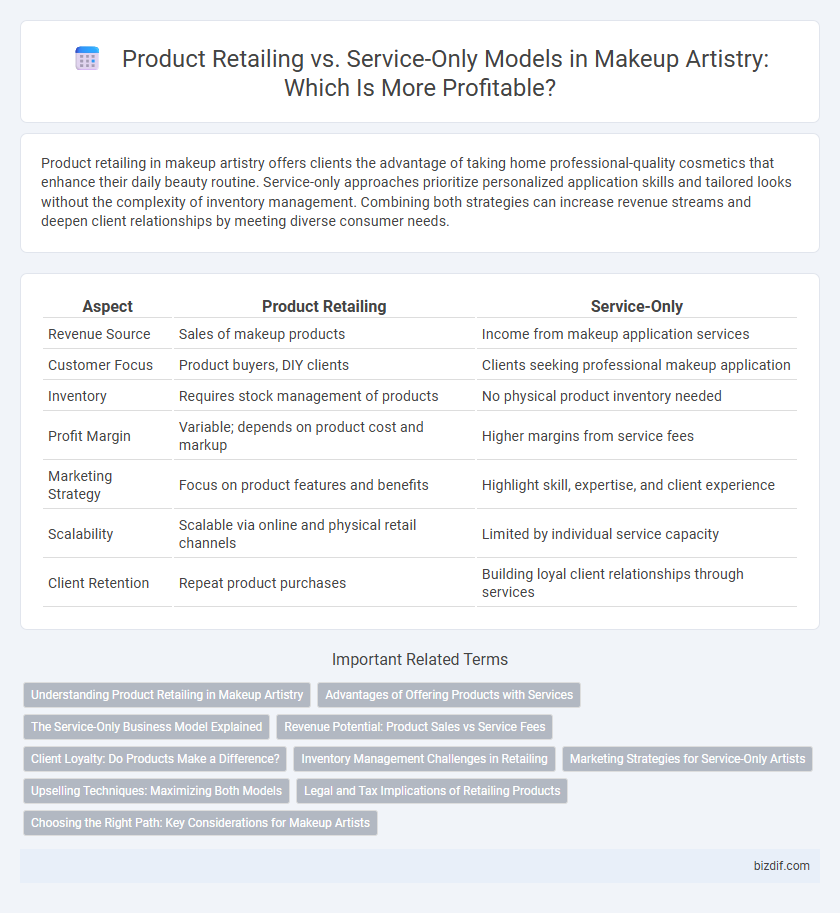Product retailing in makeup artistry offers clients the advantage of taking home professional-quality cosmetics that enhance their daily beauty routine. Service-only approaches prioritize personalized application skills and tailored looks without the complexity of inventory management. Combining both strategies can increase revenue streams and deepen client relationships by meeting diverse consumer needs.
Table of Comparison
| Aspect | Product Retailing | Service-Only |
|---|---|---|
| Revenue Source | Sales of makeup products | Income from makeup application services |
| Customer Focus | Product buyers, DIY clients | Clients seeking professional makeup application |
| Inventory | Requires stock management of products | No physical product inventory needed |
| Profit Margin | Variable; depends on product cost and markup | Higher margins from service fees |
| Marketing Strategy | Focus on product features and benefits | Highlight skill, expertise, and client experience |
| Scalability | Scalable via online and physical retail channels | Limited by individual service capacity |
| Client Retention | Repeat product purchases | Building loyal client relationships through services |
Understanding Product Retailing in Makeup Artistry
Product retailing in makeup artistry enhances client experience by offering curated cosmetic items that complement professional services, encouraging repeat business and brand loyalty. Incorporating retail products provides artists with an additional revenue stream while reinforcing their expertise through personalized product recommendations. This strategic approach balances artistry with commerce, fostering a holistic beauty service model that meets client needs both in-studio and at home.
Advantages of Offering Products with Services
Offering makeup products alongside services enhances customer satisfaction by providing personalized recommendations and immediate purchase options, increasing convenience and trust. Retailing professional-grade products boosts revenue streams and brand loyalty, as clients associate the makeup artist with quality and expertise. Bundling products with services encourages repeat business and fosters long-term client relationships, strengthening overall profitability.
The Service-Only Business Model Explained
The service-only business model in makeup artistry centers on offering personalized application, consultations, and expert techniques without selling physical products, emphasizing skill and customized client experiences. This approach reduces inventory costs and allows artists to focus entirely on client satisfaction and artistry quality. By specializing solely in services, makeup artists can build strong client relationships and adapt quickly to evolving trends without the constraints of product retail logistics.
Revenue Potential: Product Sales vs Service Fees
Makeup artistry businesses generate revenue through both product retailing and service fees, with product sales often providing higher profit margins due to wholesale purchasing and markups. Service-only models rely strictly on appointment-based fees, which can be limited by time and availability, potentially capping overall revenue. Combining product sales with services diversifies income streams, increases customer lifetime value, and maximizes total revenue potential by leveraging both immediate service payments and ongoing product purchases.
Client Loyalty: Do Products Make a Difference?
Offering retail products alongside makeup artistry services significantly enhances client loyalty by allowing customers to maintain their desired look between appointments. Clients who purchase recommended products develop trust in the artist's expertise and feel more connected to the brand. Studies in beauty retail show that combined service and product offerings can increase repeat bookings by up to 30%, highlighting the impact of retail on client retention.
Inventory Management Challenges in Retailing
Inventory management challenges in makeup artistry retailing include balancing diverse product SKUs, expiration dates, and seasonal trends to avoid stockouts or overstock. Maintaining accurate stock levels requires robust tracking systems to manage fast-moving consumables like foundations and palettes alongside slower-selling specialty items. Service-only models bypass these complexities by eliminating product inventory, allowing artists to focus solely on skill and client experience without stock management burdens.
Marketing Strategies for Service-Only Artists
Service-only makeup artists thrive by emphasizing personalized consultations and showcasing portfolio versatility through social media platforms to build trust and brand authority. Leveraging client testimonials and creating engaging video tutorials can enhance visibility and demonstrate expertise without relying on product sales. Strategic partnerships with local event planners and salons amplify market reach and reinforce the artist's professional reputation.
Upselling Techniques: Maximizing Both Models
Upselling techniques in makeup artistry leverage product retailing by recommending complementary cosmetics alongside service applications, increasing overall revenue and client satisfaction. Service-only models maximize upselling through personalized consultations that highlight advanced treatments or seasonal looks, encouraging repeat appointments and premium service packages. Integrating tailored product suggestions with expert service advice yields optimal financial and customer experience outcomes in both retail and service-exclusive frameworks.
Legal and Tax Implications of Retailing Products
Retailing makeup products requires compliance with stringent regulations, including product safety standards and proper labeling under the FDA's guidelines. Tax implications involve collecting sales tax on retail items, necessitating separate accounting practices distinct from service revenue. Failure to adhere to these legal and tax obligations can result in fines, audits, or business license revocations, making it essential for makeup artists to maintain meticulous records and stay updated on local laws.
Choosing the Right Path: Key Considerations for Makeup Artists
Makeup artists must evaluate the benefits of product retailing versus offering service-only options based on target clientele and revenue goals. Retailing products can create passive income streams and build brand loyalty, while service-only focuses on expertise and personalized client experiences. Understanding market demand, inventory management, and profit margins is crucial for selecting the right business model in the competitive beauty industry.
Product retailing vs Service-only Infographic

 bizdif.com
bizdif.com